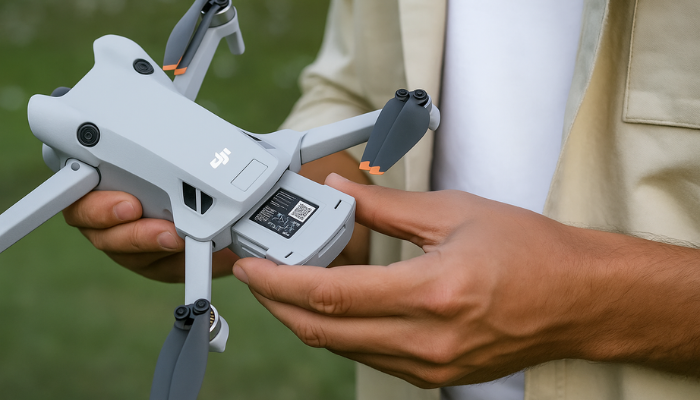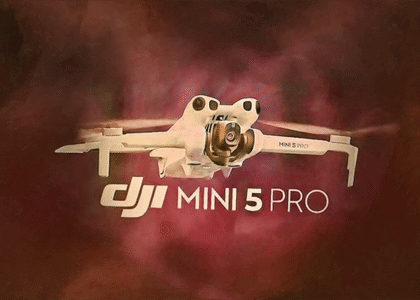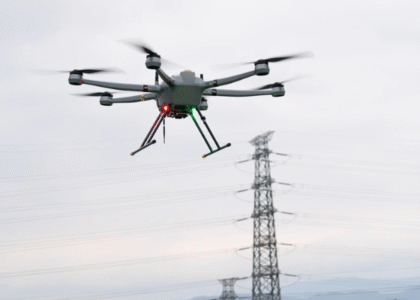Right, here’s the thing, you’ve just spent a tidy sum on a shiny second-hand DJI drone, visions of cinematic landscapes and top-down city shots dancing in your head. You power it up, fire up the controller, and then……nothing. Not a beep, not a bind, just a flashing light mocking your ambitions. Welcome to the glorious world of DJI’s mandatory rebinding policy, where a firmware update or change in ownership can leave your drone about as useful as a brick with wings.
Starting June 2025, DJI has drawn a line in the sand: no rebind, no flight. What used to be a polite suggestion buried deep in the user manual is now gospel law, enforced with the kind of rigidity you’d expect from airport security. And while the rulebook has expanded, the explanations haven’t. That’s where this guide comes in.
Rebinding a DJI drone can feel daunting especially when you need to transfer ownership, recover from a corrupted controller link, or ensure compatibility after significant firmware updates. Many operators, from aerial surveyors to hobbyists, find themselves grounded by unexpected setup hiccups.
1. Understanding Drone Binding Versus Rebinding
Binding creates a dedicated, secure radio channel between your drone’s flight controller and its remote control. This exclusive link prevents interference, ensures responsiveness, and governs access to advanced flight functions.
Rebinding becomes essential when you replace or reset a controller, acquire a second‑hand aircraft, or after certain firmware update procedures that may clear stored binding data. Rebinding a DJI drone differs from initial binding in that it often follows a deliberate unbinding of previous credentials. Without a clear rebinding routine especially after major firmware updates operators risk inconsistent controls, flight authorization errors, or even full system lockouts.
2. Why Rebinding Is Mandatory
Rebinding is not simply a procedural step, it is a regulatory and operational imperative. Manufacturers often link firmware versions and flight permissions to a specific controller, ensuring that only authorized pilots and correct hardware configurations can operate the drone.
For second‑hand sales, rebinding protects previous owner’s accounts and flight logs, while guaranteeing new operators full access. Additionally, certain firmware updates automatically clear binding credentials without a mandatory rebinding process, drones can become inoperable or fail compliance checks.
In regions with strict UIN or GCS (Ground Control Station) regulations such as India’s Digital Sky framework, rebinding ensures your aircraft remains legally registered under the correct operator profile.
In particular, DJI’s decision to enforce mandatory rebinding for all used drones from June 19, 2025 represents a pivotal shift in consumer drone governance. What was once a recommended best practice is now an uncompromising requirement with explicit penalties for failure to comply, including restricted flight operations and revoked support privileges.
3. Prerequisites and Safety Checks
Before you begin the rebinding setup, ensure that all batteries are charged, antennas and connectors show no visible damage, and the latest DJI Fly app is installed on a compatible device. A stable internet connection is recommended for firmware queries.
Always perform a quick compass calibration and check GPS lock indoors; even minor magnetic interference can derail the pairing process. Conducting these brief safety checks before heading to your launch site reduces downtime and preserves valuable flight windows.
4. Step-by-Step Rebinding Tutorial
Note: Procedures may vary slightly by model (Mavic, Air, Mini series), but core steps apply universally.
- Unbind Existing Controller:
- Power on drone and controller.
- Open DJI Fly > Profile > Aircraft > “Unbind Controller.”
- Power on drone and controller.
- Activate Pairing Mode on Drone:
- Locate the bind button (usually near the battery compartment).
- Press and hold until LEDs flash.
- Locate the bind button (usually near the battery compartment).
- Initiate Binding on Controller:
- Connect your mobile device to the controller.
- In DJI Fly, go to Aircraft Settings > Safety > “Bind Remote Controller.”
- Connect your mobile device to the controller.
- Confirm Binding:
- Watch for solid LED status on both units.
- Perform a quick control test (yaw, pitch, roll).
- Watch for solid LED status on both units.
- Firmware Update Check:
- DJI Fly will prompt if new firmware is available.
- Always apply critical updates before the first flight.
- DJI Fly will prompt if new firmware is available.
Immediately after successful pairing, the app will automatically prompt you for any pending firmware update. Skipping critical updates can reintroduce binding errors, so apply them before your initial post‑rebind flight.
Once the update completes, perform another quick control test and compass calibration to finalize the rebinding setup.
5. Affected Models
The following table outlines the DJI series and specific models subject to the mandatory rebinding policy:
| Series | Affected Models |
| Mavic | Mavic 4 Pro, Mavic 3 Pro, Mavic 3 Pro Cine, Mavic 3 Classic, Mavic 3 Cine, Mavic 3 Standard |
| Air | Air 3S, Air 3, Air 2S, Mavic Air 2 |
| Mini | Mini 4K, Mini 4 Pro, Mini 2 SE, Mini 3 Pro, Mini 3, Mini SE, Mini 2 |
| Avata | Avata 2, Avata |
| New | DJI Flip, DJI Neo |
6. Repair Complications
Technical teams servicing these drones often face several overlapping challenges. Firmware corruption can occur when a manual flash is interrupted, clearing binding credentials and necessitating a complete rebind.
Antenna misalignment from rough handling reduces signal strength, making pairing unreliable until realigned or replaced. Repeated disassembly and reassembly accelerate wear on the bind button mechanism, which may require precise reattachment or full component replacement to restore proper actuation.
Finally, mismatched firmware versions between controller and flight controller can introduce incompatible radio protocols, leading to failed bindings until both units share a synchronized firmware revision.
The following chart summarizes the most commonly affected DJI models and the typical complications encountered during maintenance or controller repairs:
| Model | Common Repair Complications |
| Mavic 4 Pro | Bind button de‑soldering, firmware rollback conflicts |
| Mavic 3 Pro | Bind button de‑soldering, firmware rollback conflicts |
| Mavic 3 Pro Cine | Bind button component wear, pairing memory corruption |
| Mavic 3 Classic | Firmware version mismatch, antenna connector fatigue |
| Mavic 3 Cine | Firmware rollback conflicts, memory clearing during manual flash |
| Mavic 3 Standard | Button actuation failure, intermittent radio signal |
| Air 3S | Antenna misalignment, corrupted pairing memory after firmware flash |
| Air 3 | Antenna connector fatigue, firmware sync errors |
| Air 2S | Antenna connector fatigue, corrupted pairing memory after flash |
| Mavic Air 2 | Connector wear, memory clearing during manual firmware update |
| Mini 4K | Button housing misalignment, signal interference after reassembly |
| Mini 4 Pro | Button misalignment, pairing loop failures |
| Mini 2 SE | Component de‑mounting damage, intermittent bind signal |
| Mini 3 Pro | Button housing misalignment, intermittent signal degradation |
| Mini 3 | Housing wear, firmware flash interruptions causing memory loss |
| Mini SE | Button mechanism wear, unstable controller link |
| Mini 2 | Connector fatigue, pairing memory corruption |
| Avata 2 | Protocol mismatch, FPV goggle sync failures |
| Avata | Protocol mismatch, controller LED indicator failures, goggle linking |
| DJI Flip | Accessory linking errors, firmware sync mismatches |
| DJI Neo | Autonomous feature sync errors, accessory pairing complications |
7. Tools and Resources
The official DJI Fly app offers a user‑friendly interface for binding commands, firmware checks, and flight logging. DJI Assistant 2 (desktop) provides advanced log review and manual firmware flashing for situations where over‑the‑air updates fail.
In India, the Digital Sky Portal remains the regulatory hub for UIN registration and operational approvals. For end‑to‑end support, from equipment selection to advanced training, FlyandTech offers an extensive catalog of DJI drones alongside expert‑led workshops tailored to both newcomers and enterprise teams.
Conclusion
Mastering the rebinding of your DJI drone is fundamental to uninterrupted aerial operations. A rigorous setup protocol, combined with timely firmware updates, safeguards against in‑field disruptions and regulatory hiccups.
Whether you’re deploying drones for surveying, filmmaking, or inspection, this guide equips you with the confidence to rebind swiftly and fly safely. If you are seeking best‑in‑class hardware and specialized training, FlyandTech stands ready as your trusted partner delivering premium drones and comprehensive instruction to help you achieve every flight objective.
FAQs
1. How soon after a firmware update should I rebinding my DJI drone?
A. Immediately verify the binding link once your firmware update completes; rebinding is recommended if you notice any latency or command dropouts.
2. Can the same remote controller bind to multiple DJI models?
A. Yes, provided the models share the same radio protocol (e.g., RC-N2 controllers can bind both Air 2S and Mavic 3 series).
3. What steps should I take if the rebinding tutorial fails repeatedly?
A. Inspect your antennas for damage, ensure compass calibration remains accurate, and use DJI Assistant 2 to review flight logs for binding errors, then retry the setup.







